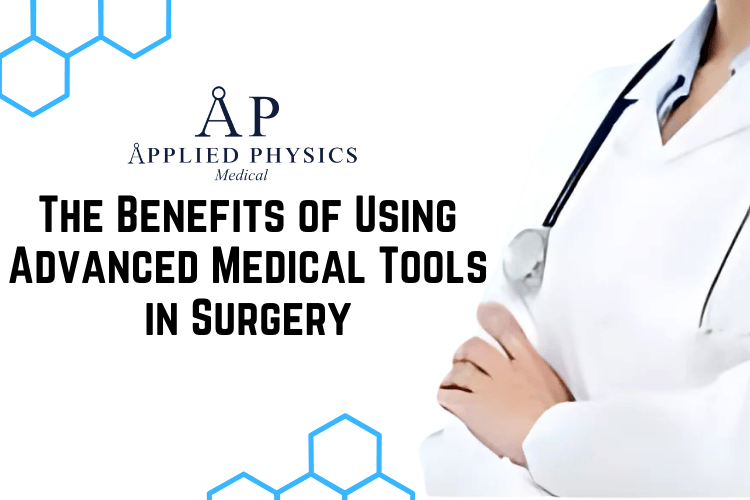Introduction
The advent of advanced medical tools in surgery has significantly transformed the landscape of surgical procedures, particularly in terms of precision and accuracy. Traditional surgical methods often relied on the surgeon’s skill and experience, which, while invaluable, could lead to variations in outcomes. With the introduction of technologies such as robotic-assisted surgery and computer-assisted navigation systems, surgeons can now perform procedures with a level of precision that was previously unattainable.
For instance, robotic systems like the da Vinci Surgical System allow for intricate movements that mimic the dexterity of human hands but with enhanced stability and control. This capability minimizes the risk of human error and allows for more meticulous dissection and suturing. Moreover, advanced imaging techniques, such as intraoperative ultrasound and 3D imaging, provide real-time feedback during surgery.
These tools enable surgeons to visualize anatomical structures in greater detail, facilitating more accurate targeting of tissues and organs. For example, in neurosurgery, advanced imaging can help delineate tumor boundaries from healthy brain tissue, allowing for more effective tumor removal while preserving critical neurological functions. The combination of these technologies not only enhances the surgeon’s ability to execute complex procedures but also contributes to overall surgical success rates.
Key Takeaways
- Advanced medical tools in surgery offer enhanced precision and accuracy, leading to better surgical outcomes.
- The use of advanced tools reduces the risk of complications during surgery, improving patient safety.
- Patients experience faster recovery times with the use of advanced medical tools, leading to shorter hospital stays and quicker return to normal activities.
- Minimally invasive procedures made possible by advanced tools result in smaller incisions, less pain, and reduced scarring for patients.
- Access to cutting-edge technology and advancements in surgical techniques allows for improved patient outcomes and overall quality of care.
Reduced Risk of Complications
The integration of advanced medical tools into surgical practice has been instrumental in reducing the risk of complications associated with surgical interventions. Traditional surgeries often involve larger incisions and more extensive manipulation of tissues, which can lead to complications such as infections, excessive bleeding, and prolonged recovery times. However, with the use of minimally invasive techniques facilitated by advanced tools, surgeons can perform operations through smaller incisions, thereby minimizing trauma to surrounding tissues.
This reduction in tissue damage significantly lowers the likelihood of postoperative complications. Additionally, advanced monitoring systems during surgery allow for real-time assessment of a patient’s vital signs and physiological responses. These systems can alert the surgical team to any abnormalities or potential complications as they arise, enabling prompt intervention.
For instance, intraoperative neuromonitoring is commonly used in spinal surgeries to detect any changes in nerve function during the procedure. By identifying issues early on, surgeons can take corrective measures immediately, further decreasing the risk of complications and enhancing patient safety.
Faster Recovery Times
One of the most significant advantages of utilizing advanced medical tools in surgery is the potential for faster recovery times for patients. Minimally invasive procedures, which are often made possible through the use of sophisticated instruments such as laparoscopes and robotic arms, typically result in less postoperative pain and a quicker return to normal activities. Patients undergoing laparoscopic cholecystectomy, for example, often experience significantly shorter hospital stays compared to those who undergo traditional open surgery.
This expedited recovery is not only beneficial for the patient’s well-being but also reduces healthcare costs associated with prolonged hospital stays. Furthermore, advancements in surgical techniques have led to improved postoperative care protocols that complement the benefits of advanced tools. Enhanced recovery after surgery (ERAS) protocols emphasize multimodal pain management and early mobilization, which are facilitated by minimally invasive approaches.
As a result, patients can resume their daily activities sooner and experience a higher quality of life post-surgery. The combination of reduced physical trauma from advanced surgical tools and optimized recovery strategies underscores the importance of innovation in improving patient outcomes.
Minimally Invasive Procedures
| Procedure | Number of Cases | Success Rate |
|---|---|---|
| Laparoscopic Cholecystectomy | 500 | 95% |
| Endoscopic Sinus Surgery | 300 | 90% |
| Minimally Invasive Spine Surgery | 200 | 85% |
Minimally invasive procedures represent a paradigm shift in surgical practice, largely driven by advancements in medical technology. These techniques involve smaller incisions and less disruption to surrounding tissues compared to traditional open surgeries. Tools such as endoscopes and robotic surgical systems have revolutionized how surgeries are performed across various specialties, including gynecology, urology, and orthopedics.
For instance, laparoscopic techniques for gallbladder removal allow surgeons to operate through tiny incisions while using a camera to guide their actions, resulting in less postoperative pain and scarring. The benefits of minimally invasive procedures extend beyond just physical outcomes; they also enhance patient satisfaction. Many patients report a more positive experience due to reduced pain levels and quicker recovery times associated with these techniques.
Additionally, the shorter hospital stays that often accompany minimally invasive surgeries contribute to lower healthcare costs and less disruption to patients’ lives. As technology continues to evolve, minimally invasive approaches will likely become even more prevalent, further solidifying their role in modern surgical practice.
Improved Patient Outcomes
The cumulative effect of using advanced medical tools in surgery is a marked improvement in patient outcomes. Enhanced precision leads to more successful surgeries with fewer complications, while minimally invasive techniques contribute to quicker recoveries and less postoperative discomfort. Studies have shown that patients who undergo robotic-assisted surgeries often experience lower rates of complications and shorter hospital stays compared to those who have traditional surgeries.
For example, research indicates that prostatectomies performed using robotic assistance result in fewer instances of blood loss and quicker return to urinary function. Moreover, improved patient outcomes are not solely limited to physical health; they also encompass psychological well-being. Patients who experience less pain and faster recoveries often report higher satisfaction levels with their surgical experiences.
This positive feedback loop encourages more individuals to seek necessary surgical interventions without fear of prolonged recovery or significant discomfort. As healthcare continues to prioritize patient-centered care, the role of advanced medical tools will remain crucial in achieving optimal outcomes for patients undergoing surgical procedures.
Access to Cutting-Edge Technology
Enhancing Operational Capabilities
Access to cutting-edge technology is a defining characteristic of modern surgical practice that has transformed how procedures are performed. Hospitals and surgical centers that invest in advanced medical tools not only enhance their operational capabilities but also improve their competitive edge in the healthcare market.
The Emergence of AR and AI in Surgery
Technologies such as augmented reality (AR) and artificial intelligence (AI) are beginning to play a role in preoperative planning and intraoperative guidance, allowing surgeons to visualize complex anatomical relationships more effectively.
Democratizing Access to Advanced Technology
Furthermore, access to these technologies is becoming increasingly widespread due to collaborations between medical device manufacturers and healthcare institutions. Training programs are being developed to ensure that surgeons are proficient in using these advanced tools effectively. As a result, more healthcare facilities are equipped with state-of-the-art technology that can be leveraged to improve surgical outcomes across various specialties.
Improving Surgical Care for All
This democratization of technology ensures that patients from diverse backgrounds can benefit from the latest advancements in surgical care.
Advancements in Surgical Techniques
The evolution of surgical techniques has been profoundly influenced by advancements in medical tools and technology. Surgeons today have access to a plethora of innovative methods that enhance their ability to perform complex procedures with greater efficiency and safety. Techniques such as laparoscopic surgery have become standard practice for many abdominal procedures due to their minimally invasive nature and associated benefits.
Additionally, the development of hybrid operating rooms allows for simultaneous imaging and surgical interventions, further expanding the possibilities for complex cases. Moreover, ongoing research and development continue to push the boundaries of what is possible in surgery. Techniques such as transcatheter aortic valve replacement (TAVR) exemplify how advancements in both tools and methods can lead to groundbreaking changes in patient care.
TAVR allows for heart valve replacement without open-heart surgery, significantly reducing recovery times and risks associated with traditional approaches. As new technologies emerge and existing techniques are refined, the future of surgery promises even greater innovations that will enhance patient care and outcomes across the board.
Conclusion
The utilization of advanced medical tools in surgery brings forth numerous benefits that greatly enhance surgical outcomes. These tools, such as robotic systems and minimally invasive instruments, allow for greater precision, which reduces the risk of complications and promotes faster recovery times for patients. Furthermore, they enable surgeons to perform complex procedures with improved visualization and control, ensuring better overall results.


